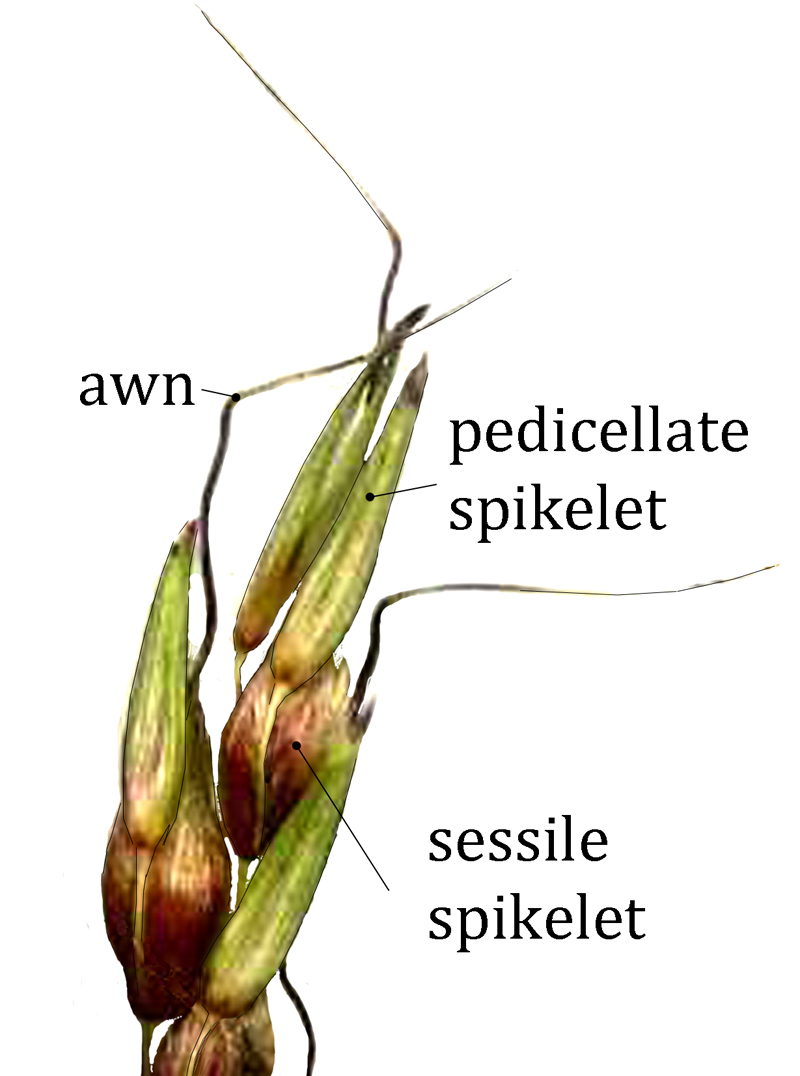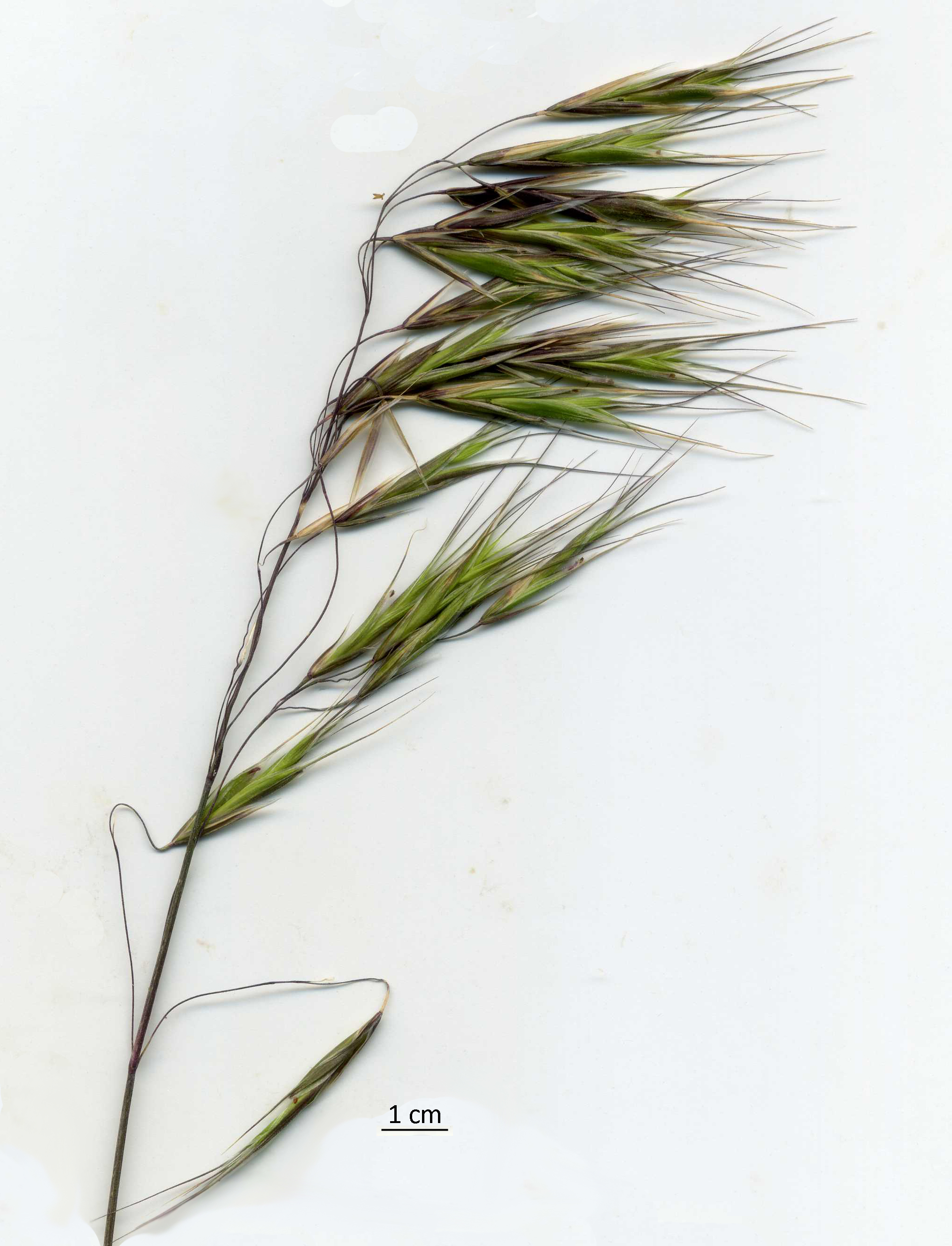|
|
|
[PANICULATE INFLORESCENCES CONTINUED]
|
|
|
|
|
101a
|
( 83) 83) |
A single, fertile floret above each glume pair. Spikelets with one or two awns .. .
|
|
[102] |
|
101b
|
|
Multiple, fertile florets above each glume pair. Spikelets with more than two awns .. .
|
|
[111] |
|
~~~~ ~~~~~~~~~~~~~~~~~~~~~~~~~
|
|
|
102a
|
(101) |
Inflorescence an erect, panicle of paired spikelets, each greater than 2.5 mm long .. .
|
|
[103]
|
|
102b
|
|
Panicles dense, spikelets narrow, up to 2.5 mm long. Medium-size perennial grass with hairy, sticky leaves (particularly the sheaths). Strong-smelling (like molasses). Inflorescence varies from very narrow to narrow ovoid, purple-tinged. { Widely distributed in dry to mesic sites above 400 ft elevation. Molasses grass [HAW - NAT] [FAC]; Molasses grass [GUM - ?NAT] [FAC]Melinus minutiflora P. Beauv.
|
|
|
~~~~ ~~~~~~~~~~~~~~~~~~~~~~~~~
|
|
|
103a
|
(102) |
Spikelets 2 to 6 mm long excluding awn, paired: sessile spikelet perfect, awned; pedicellate spikelet not awned .. .
|
|
[104] |
|
103b
|
|
Spikelets 9 mm (>5/16 in) or more long not including awn(s), which exceed length of spikelet .. .
|
|
[107] |
|
~~~~ ~~~~~~~~~~~~~~~~~~~~~~~~~
|
|
|
104a
|
(103) |
Inflorescence of one to many racemes, these typically paired or digitally arranged on erect branchlets; spikelets paired, more or less similar, but only sessile one with long awn. Medium size grasses. Dichanthium spp. .. .
| |
[106] |
|
104b
|
|
 Paired spikelets disimilar, stalked spikelet (two at branch end) narrow, sterile or male only; sessile spikelet with a twisted and bent awn. Leaves wide, with conspicuous midrib. blade and sheath glabrous, except densely pubescent at throat; ligule membranous, dark, conspicuously longest at middle, fringed with short tight hairs.{ Inflorescence varies from crowded to somewhat open, narrow ovoid to spindle-shaped, or drooping. Large grasses. Sorghum spp. .. .
Paired spikelets disimilar, stalked spikelet (two at branch end) narrow, sterile or male only; sessile spikelet with a twisted and bent awn. Leaves wide, with conspicuous midrib. blade and sheath glabrous, except densely pubescent at throat; ligule membranous, dark, conspicuously longest at middle, fringed with short tight hairs.{ Inflorescence varies from crowded to somewhat open, narrow ovoid to spindle-shaped, or drooping. Large grasses. Sorghum spp. .. .
Figure 16A. Photo drawing of (seven) Sorghum spikelets. Note terminal sessile spikelet is associated with two pedicellate spikelets, the others with one each.
|
|
[105] |
|
~~~~ ~~~~~~~~~~~~~~~~~~~~~~~~~
|
|
|
105a
|
(104) |
Raceme somewhat fragile. Grain conspicuous, shiny white at maturity. { Large rhizomatous, perennial (Fig. 16A). Johnson grass [HAW - NAT] [FACU]; Johnson grass [GUM - NAT]Sorghum halepense (L.) Pers.
|
|
|
105b
|
|
Raceme tough, tardily disarticulating. Grain large, spreading the glumes (some black), colored reddish brown at maturity. { Large annual. [HAW - NAT] [FACU]; broomcorn [GUM - NAT]Sorghum bicolor (L.) Moench
|
|
|
~~~~ ~~~~~~~~~~~~~~~~~~~~~~~~~
|
|
|
107a
|
(103) |
Large perennial with dense, open, but typically drooping inflorescence. Apparent spikelets on mostly stiff branches arising from the leaf sheaths. Actual spikelets are mostly much reduced and number 3-6 above a 3-3.5 cm (>1 in) spathe. Two spikelets with long awns in each complex raceme, although often missing. Conspicuous is a black, rufous pubescent, truncated glume surrounding each spikelet. { Naturalized in dry to mesic pastures and other disturbed sites to 2500-ft elevation. HDA noxious weed. Lyon's grass [HAW - NAT]Themeda villosa (Poir.) A. Camus
|
|
|
107b
|
|
Spikelets single on narrow pedicels branching off the rachis. Medium to large grass with open and not particularly dense inflorescence. Two awns per spikelet. Avena spp. .. .
|
|
[108] |
|
~~~~ ~~~~~~~~~~~~~~~~~~~~~~~~~
|
|
|
108a
|
(107) |
Rachilla and lemma glabrous or sparesely pubescent. Long awns straight or weakly bent. Florets not deciduous .. .
|
|
[109] |
|
108b
|
|
Rachilla and lemma hairy. Long awns typically bent. Florets readily deciduous, disarticulating above glumes and between floret pair .. .
|
|
[110] |
|
~~~~ ~~~~~~~~~~~~~~~~~~~~~~~~~
|
|
|
109a
|
(108) |
Lemma glabrous at base. Long awns typically straight. Tip of lemma entire or slightly bilobed, without awns. Florets not deciduous, persisting. { Medium to large annual grass, cultivated as forage, but naturalized in disturbed places and pastures. Common oat [HAW - ORN,NAT] [FAC] [GUM - ORN]
|
|
|
109b
|
|
Lemma glabrous but rachilla of second floret ciliolate on upper edges. Long awns slightly bent. Tip of lemma with two short awns. { Medium to large annual grass, cultivated as forage on Kaua‘i (coll. 2013). Hybrid oat. [HAW - ORN] [FAC]Avena sativa hybrid or cross?
|
|
|
~~~~ ~~~~~~~~~~~~~~~~~~~~~~~~~
|
|
|
110a
|
(108) |
Tip of lemma with two short awns. Lemma hairs white. Naturalized on O‘ahu, Maui, and Hawai‘i. [HAW - NAT]Avena barbata Pott ex Link
|
|
|
110b
|
|
Tip of lemma toothed, but without bristles or awns. Lemma hairs yellow to brown. Wild oat [HAW - NAT]
|
|
|
~~~~ ~~~~~~~~~~~~~~~~~~~~~~~~~
|
|
|
111a
|
(101) |
Spikelets tapering towards the tip. Lemmas up to 0.5 in (1 cm) long and 0.1 in (2.5) mm wide in side view. Lower glume 3-7 veined. Awns straight, about 1/4-in (4-9 mm) long. { found in dry areas above 1,000 ft. [HAW - NAT] [UPL]
|
|
111b
|
|
Spikelets gaping somewhat at the tip. Lemmas 0.5 to 1.25 in (1 to 3 cm) long and less than 0.1 in (1-1.5 mm) across in side view. Lower glume with a single vein
|
|
[112] |
|
~~~~ ~~~~~~~~~~~~~~~~~~~~~~~~~
|
|
|
112a
|
(111) |
 Panicle open and drooping. Lemmas 0.5 to 0.8 in (1-2 cm) long, membranous and bifid at the tip, supporting a scabrous awn, straight and 0.5 to 0.7 in (1-1.7 cm) long. { Adventive on East Maui. Cheatgrass [HAW - NAT]
Panicle open and drooping. Lemmas 0.5 to 0.8 in (1-2 cm) long, membranous and bifid at the tip, supporting a scabrous awn, straight and 0.5 to 0.7 in (1-1.7 cm) long. { Adventive on East Maui. Cheatgrass [HAW - NAT]
Figure 16B. Inflorescence of B. tectorum.
|
|
|
|
112b
|
|
Spikelets larger, Lemmas 2-3 cm long, bifid at the tip, supporting a scabrous awn 1 to 2 in (30-60 mm) long. { Common in pastures, subalpine forest and shrubland, and disturbed areas. Ripgut brome [HAW - NAT]
|
|
|